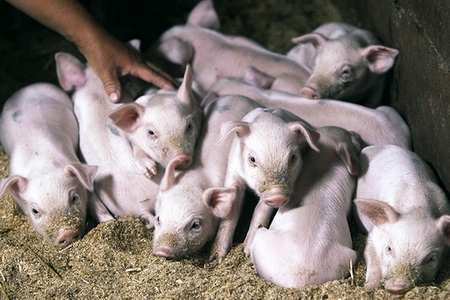
Minnesota State Fair officials are hoping for the best, but should a lethal swine virus that’s now spread to 16 states make an appearance at the beloved 12-day-long state fair later this month, officials have a plan in place.
“We’ve put together a letter trying to educate the [400-500 individual] exhibitors about the things they need to do,” says Mark Goodrich, deputy general manager of the Minnesota State Fair. That letter includes information about monitoring the pig’s health; disinfecting the trailer used to transport the animal; a reminder to clean boots, shoes and clothing; and a caution to exhibitors about sharing equipment with others. Should an animal become ill, they have a plan for that as well.
“We have an isolation building that is separate from any of the barns, and we have veterinarians that will inspect all the animals two to three times a day, looking for visual signs of sickness,” says Goodrich.
What officials in Minnesota and throughout the country are concerned about is the deadly Porcine Epidemic Diarrhea Virus (PEDV), which has been killing young piglets in numbers (some estimate to be in the tens of thousands) and has been spreading since it was first detected in Ohio on April 15.
The virus is not a threat to humans who touch the animals or partake of a state fair favorite, pork-on-a-stick.
“I don’t think anyone is in a panic, but producers and vets are concerned,” Tom Burkgren, executive director of the American Association of Swine Veterinarians, tells TakePart. “PEDV is very infectious. It spreads fast and is very deadly on pigs that are under three weeks of age. The death loss has been up to 100 percent.”
Adult pigs seem to be able to weather the diarrhea and vomiting symptoms associated with the virus, and then eventually recover, passing immunity on to future offspring. But in the meantime, economic losses to farmers who lose piglets could be devastating.
An update on positive case submissions is expected to be released Wednesday evening, says Burkgren.
In the meantime, there’s a lot about the virus we don’t know, including the total number of pig deaths in the current outbreak. Steve Meyer, an industry consultant, said in a client newsletter that it could be as high as 60,000-1000,000 pigs since June. But the fact of the matter is, no one is officially keeping track, and there’s no requirement for producers to report the disease. The National Pork Board is taking the outbreak seriously, however, and is investing $800,000 to combat the virus.
We also don’t know how the virus, which was discovered in the United Kingdom in the early 1970s, and eventually spread to Asia, found its way here in the U.S.
“It is related to a virus isolated in China in 2012,” says Burkgren. “It’s 99.4 percent similar. That’s not completely identical, but it’s very close. How did it enter the U.S. prior to April 15? That’s the million-dollar question.”
While officials try and figure that out, state fair season is in full bloom.
In preparation for county competitions and the Iowa State Fair, Ron Birkenholz, spokesperson for the Iowa Pork Producers, says they’ve been busy getting the word out to hog producers about PEVD.
“We’ve been imploring the producers around the state to step up their biosecurity measures. There’s some indication the virus is being transmitted through transportation. Show pigs [like those that end up at state fairs] aren’t usually mingled in with commercial pigs,” he says.
The Iowa State Fair, which starts on Thursday, will have swine barn officials and veterinarians on site to closely check pigs at the show. While market pigs (read: meat pigs) generally get slaughtered at the end of the fair, the concern with PEVD centers more around breeding pigs, which are sold and then transported to other farming communities both in and out of state.
“One thing about the Iowa State Fair is for the last five years, no pigs are allowed in the swine barn for more than three days,” says Birkenholz. “That doesn’t allow any virus to spread, and we feel confident that we shouldn’t have a problem this year.”
TakePart asked officials from the Ohio State Fair, which ended August 4, if policies regarding swine competitions or exhibitions were altered after the virus was confirmed to be present in the state. Virgil Strictler, general manager for the fair, and Alicia Shoults, spokesperson, refused to answer and referred us to the Ohio Department of Agriculture.
Erica Hawkins, communications director for that department, told TakePart that she believes a letter was sent by the barn superintendent to exhibitors prior to the start of the fair, and that farmers were informed when they checked in.
“They had the option to not unload if they didn’t feel comfortable,” says Hawkins. “A handful opted to stay home given the risk, and for the most part, they came. We stressed the risk of an outbreak at the fair was pretty low.”
PEVD won’t be keeping Tim Marek or his four daughters away from exhibiting at the Iowa State Fair this year.
“We raise show pigs. It’s our livelihood,” he tells TakePart. “PEVD is a concern, but I remember a few years ago with H1N1, it was blown out of proportion. The Iowa Pork Producers and the Pork Board have been doing a good job communicating.
“We all raise hogs for a living. New strains pop up. It’s a concern, and we talk some about it. We know there’s a risk in what we do.”





